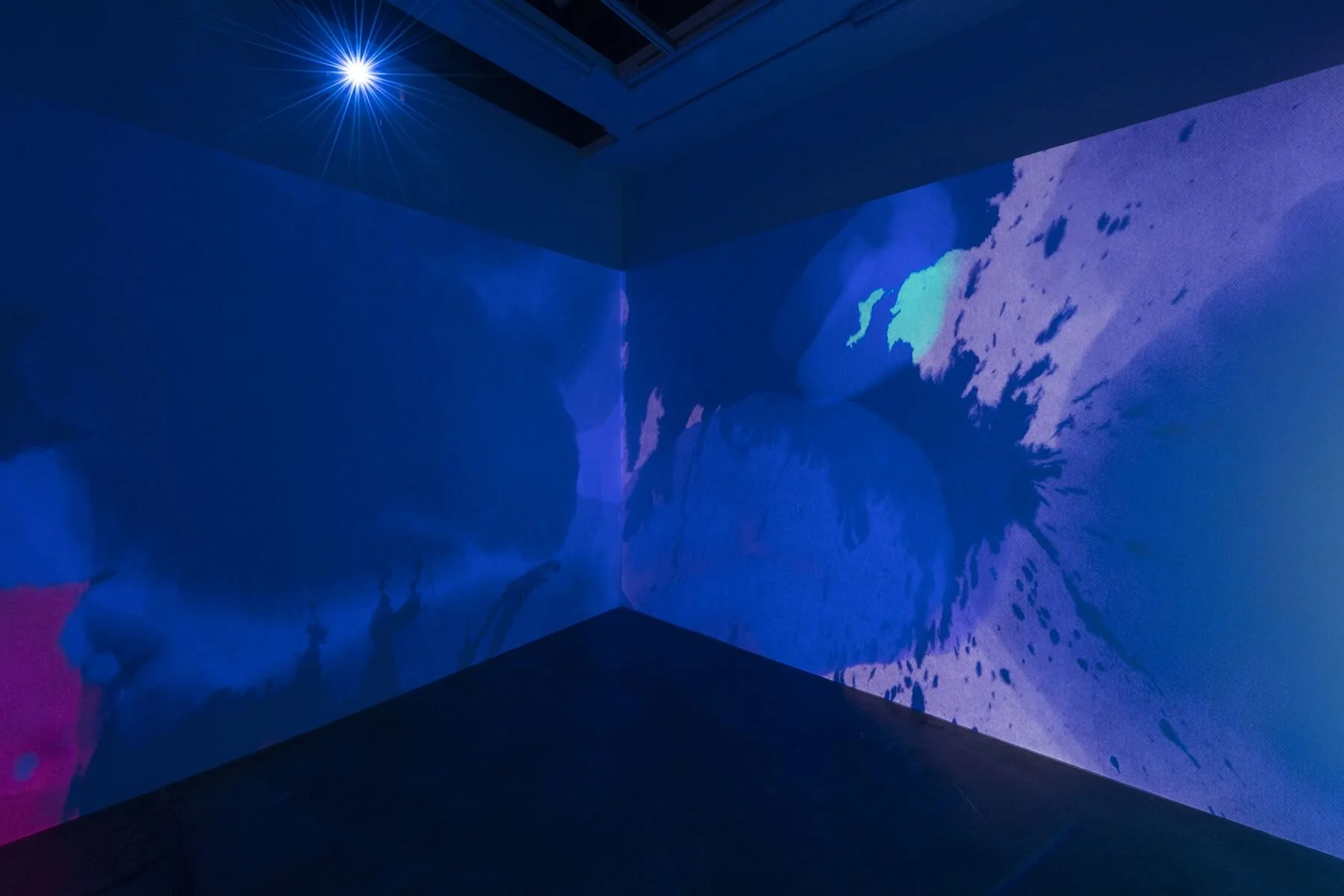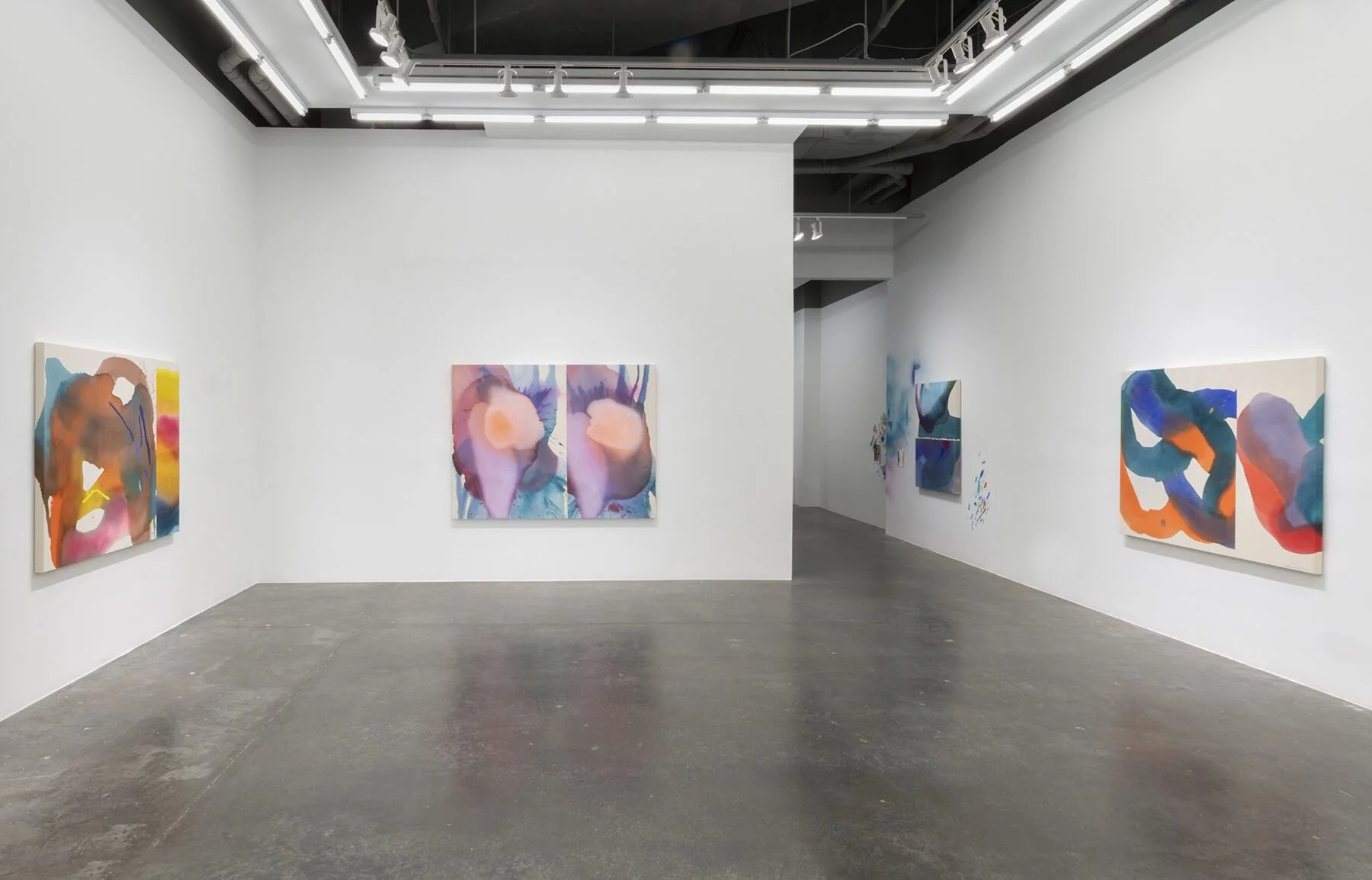Heather Day
After following Heather Day’s work for a number of years in the Bay Area, her first New York solo exhibition proved the perfect moment for a studio visit. Heather’s painting and now digital art practice colludes playfulness with formalism in remarkable ways. Thank you to Heather for her thoughtful responses, and for her nuanced take on new media in contemporary art.
California-based artist Heather Day makes abstract paintings and digital works composed of scraped, smeared, and flooded pools of pigment on heavily worn canvases, often stitched together. Day expands the conventional surface area of a painting, treating the backs and sides of a canvas with the same value as its facade. She uses recurrent markings and reformed canvases as atoms of an idea, free to be reconfigured but always orbiting around one center. The compulsive energy of her work oscillates between rehearsed abandon and careful restraint.
In addition to Day’s core painting practice, she has been exploring ways the traditional analog medium can be expanded with the use of technology. Day’s work further bridges the imaginary gap between tactile and digital art while challenging the traditions of abstract expressionism. More recently, she has extended her studio practice to the realm of animation where she documents a painting as it comes to life, stitching those moments together in motion and combining physically painted marks with digital brush strokes.
Heather Day lives and works in California. She received a BFA from The Maryland Institute College of Art (MICA). The artist’s work has recently been shown at Misa Art Market by König Gallery in Berlin, Diane Rosenstein Gallery in LA. Previous exhibits include Fort Wayne Museum of Art in Fort Wayne, IN, The Urban Institute of Contemporary Art in Grand Rapids, MI, and The Massachusetts Museum of Contemporary Art (MASS MOCA).
Heather Day in her studio. Courtesy of the artist.
LS: What does it mean for you to be an abstract artist? How does your work fall in the historical canon of abstraction and what does it mean to be an abstract artist today?
HD: For me, abstract art lends itself to finding what’s beneath the surface by using an unspoken emotional language that could be conveyed through the weight of color, light, and texture. I’m constantly finding new ways and mediums to express how something feels rather than just depicting its form.
The dividing line between local influence and digital influence is hard to find in such an information-rich, hyper-online culture. So, my influences, both in concept and form, are wide-reaching.
My work is a synthesis of seminal paintings, artists, and styles that I bend through my own lens, careful never to get too close to anyone's reference point or steer too far in one direction.
An idea for a painting might develop over the course of a few years. Many of my marks and references come from a time when I was much younger, and the world was a much different place. There’s a constant vocabulary that is developing and evolving as I work. I don’t see that stopping. My paintings are rough drafts, or foundations for the work to follow.
Heather Day, Sounding Board, 2021, mixed media on stitched canvas, 48 x 56 inches. Courtesy of the artist and Anna Zorina Gallery
LS: Much of your new body of work uses repetition and repeated mark-making. What inspired this development and what have you learned about yourself and art-making in the process?
HD: My practice has been built around the idea of experimentation, a conscious anti-formulaic approach if you will. In anything you do, there’s still an inherent risk of falling into unconscious patterns. We’re creatures of habit; it’s in our nature as humans to find, create, and recreate patterns or to follow muscle memory.
In my new body of work, I take that idea of repetition that’s normally in the background of our everyday experience and put it under the spotlight. I leaned on the idea of human tendencies and in turn became more aware of human error.
For 6 or 7 of my new pieces in Convergence, I used muscle memory as a primary tool to guide two versions of one painting I was creating all at once. There’s a type of push and pull between each painting. The slightest change in the way I pour a bucket of paint over canvas or flick my wrist to cast paint creates differences between the two works that change my compositional decisions as I’m working.
The process underscores that in painting and life outside the studio, so much is outside of our control. What makes a difference is how we respond to change.
Heather Day. Convergence, 2021, mixed media on stitched canvas, 56 x 72 inches. Courtesy of the artist and Anna Zorina Gallery
LS: Do you see a distinction between ‘finished’ and ‘completed’ work? How has that changed since you began stitching canvases together?
HD: I think for a painting to feel finished and feel whole, it has to balance control and chaos together in one space - the story behind how the painting arrived at that balanced state. It’s me in my studio drawing, pouring pigment, cutting the canvas, tearing it, piercing apart and stitching together different ideas, destroying and dissecting sections. It’s a nonlinear process that still has a distinct story to it which I try to reflect in my work. Once I sense a painting does that, it’s complete.
I’m constantly reimagining and editing the compositions I create. Stitching gives me the ability to unite one idea with another.
LS: Color often has emotional states or values associated with them due to cultural influences and media memory. Where are your colors derived from?
HD: Absolutely, and color only translates in the context of its environment. For me, color is about relationships — what is this color pairing against and responding to? And it’s about creating access points where a color is almost serving as a lure to draw someone in.
Heather Day, Glow, 2021, mixed media on stitched canvas, 48 x 56 inches. Courtesy of the artist and Anna Zorina Gallery
LS: In what way is painting a performance for you? How does the increase in technology help document and share this performance?
HD: We tend to think of a completed work as one thing, as a single snapshot. In my work, I view a canvas as a stage. It should tell the story of how it came together and document a series of moments, not just the moment of its completion.
Technology helps me share the lifecycle of a painting. This past year I’ve incorporated both audio and video elements into my work, allowing me to tie foundational moments together in one entity.
LS: As an artist who predominantly paints, you have been adept in integrating new technologies/media into your oeuvre. What is your approach towards integrating technology-driven mediums in your practice?
HD: Documenting my studio process through film gives me a tremendous amount of freedom in my work. Physically painted markings and digitally rendered animation can influence one another at any time throughout the lifecycle of the work. There’s an element of flexibility in conducting and choreographing marks that are unique to this particular way of working and this way of combining mediums.
I have experimented quite a bit with augmented reality and virtual reality in my studio practice as well. But, in some ways, I felt that I was running in place. I wanted to avoid the feeling of technology becoming an ornament to be hung onto an idea. If I’m going to incorporate a digital medium, it should be a vital part of expressing that idea.
This brought me back to physical painting while recording my marks on film and creating a large inventory of content to edit. In my recent film work, I painted on canvas and edited the color in post-production while also painting digitally and animating my marks. This allowed me to intertwine pixels and paint interchangeably.
Installation view of Convergence at Anna Zorina Gallery, New York. Courtesy of the artist and Adam Reich.
LS: Without diving into NFT-mania as a whole, what does it offer you as an artist? What benefits do you see in working with these platforms/technologies?
HD: NFT’s offer artists a bridge to transparency and making royalties off of their work in a secondary market. That’s pretty awesome. I’m excited to see how this new concept will evolve but I think it’s extremely important that we find a way for NFT’s to be powered by clean energy and that we offset their carbon footprint.
LS: The NFT mania saw a new audience unfamiliar with the contemporary art world divert its attention towards creative work. What do you anticipate for the future in terms of contemporary art and technology platforms and digitally created work?
HD: It’s difficult to predict but I think tech and art will continue to merge. I’m really excited to live during this time to be both a witness and an artist with the opportunity to experiment.
Screen grab, Two Fathoms, Heather Day NFT 2021
LS: Some important tenants of a great artwork include being moved, feeling something, inspired, or learning something from it. Have you had this reaction to NFTS the way you have to paintings you’ve seen? When you created your first NFT, was this a consideration?
HD: We experience art on the internet every day. It might not be a “venue” in and of itself simply because you can’t label such a massive entity to be one thing or another. But, it’s undeniable that it is a place where we take in art, and it offers artists an incredible degree of reach to new audiences as well as new ways to show their work to those audiences - and in turn, learn from them. In Two Fathoms, I thought about challenging the traditional definition of a venue for art and focusing more on the impact of the art itself, as opposed to where it's displayed or how it’s valued. That said, NFTs can still live in a gallery setting. The experience of going to a gallery or public setting to see work in person is irreplaceable.
If someone can take in a work I’ve created with headphones on, inside their home and feel the weight of it, is that any less authentic or impactful than if they saw the work in a designated, traditional venue? What I valued more was my work’s impact on the observer or audience, rather than where they were located while taking in the work. While the context of where someone is while experiencing art is interesting, I think we could argue that a shift in perspective might help us democratize art further while offering a richer, more personal experience to the viewer.
Heather Day’s exhibition Convergence, curated by Ché Morales was on view at Anna Zorina Gallery June 24 to August 27, 2021. Please contact info@annazorinagallery.com for more info, or follow @heatherday on Instagram.
Installation view of Convergence at Anna Zorina Gallery, New York. Courtesy of the artist and Adam Reich and Anna Zorina Gallery.





